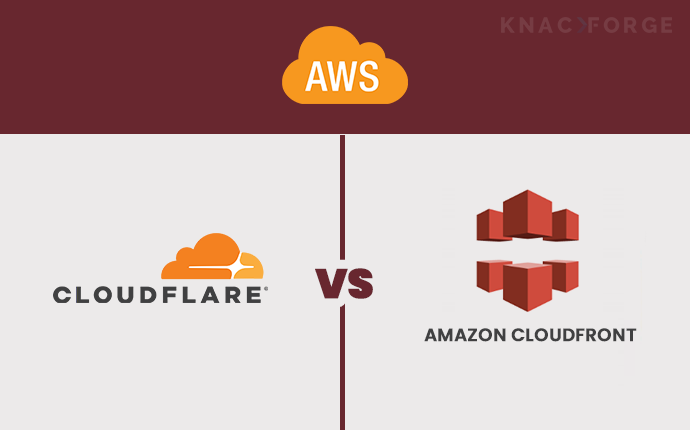
Jennifer Mary
September 26, 2022
AWS CloudFront Vs Cloudflare: How to Choose the Right CDN
- amazonwebservices
- awscloud
- CDN
- cloudadoption
- cloudcomputing
- cloudflare
- cloudfront
- CloudFrontvsCloudflare
- contentdelivery
- knackforge
- publiccloud
- solutionsarchitect
Cloudflare vs CloudFront
Cloudflare and CloudFront are services that can help reduce your website's load time. In addition to speeding up your content delivery and load times, they can provide many advantages to your organization. They both work similarly by distributing server loads across multiple servers, but they have fundamental differences. Cloudflare is a service that provides other application services such as DNS, load balancing, video streaming, DDoS attacks protection, web application firewall (WAF), analytics, domain registry, and more. At the same time, Cloudfront is just a CDN provider with the sole purpose of accelerating content delivery.
In this comparison of Amazon CloudFront vs. Cloudflare article, we’ll walk you through the right CDN for websites based on its features, cost, performance, and other key differentiators which need to be considered while choosing the best CDN for your business.
What is a CDN?
"Content Delivery Network," or "CDN," is a network of computers, servers, and nodes worldwide. You upload your website files to the 'cloud,' and then this content will be delivered via dedicated servers/nodes that are geographically closer to your end customers than the original hosting server.
What is Cloudflare?
Cloudflare is a buzzing brand in the CDN industry for its ability to provide cutting-edge performance capabilities and robust security features. It functions essentially as a reverse proxy, and its infrastructure is built from scratch, without any legacy system. It was originally intended to keep fraudsters off your website and stop them from harvesting emails. Their global infrastructure and algorithm provide advanced security systems along with performance enhancement. The incorporation of machine learning into the Cloudflare infrastructure enables it to continuously learn, adapt, and integrate to meet the complex needs of the ever-evolving technical environment.
What is CloudFront?
A relatively different or conventional CDN tool does not require you to change nameservers as you did in Cloudflare. Amazon Cloudfront is entirely different from the "Reverse Proxy" approach of Cloudflare.
Cloudfront is another well-known global CDN (Content Delivery Network) that retrieves data from the Amazon S3 bucket and distributes it to multiple data centers it acquires. It uses a network of data centers, often referred to as Edge Locations, to deliver the data centers, often referred to as Edge Locations. When a user requests data on the internet, the nearest edge location is routed, resulting in the lowest latency, low network traffic, faster access to content, and an overall better web experience.
Amazon CloudFront vs. Cloudflare: The Key Differences
Although both CDNs are meant to address the same issue of reducing load times, they have specific operational and working differences. Here's a comparison table detailing the major differences to help you choose the right service for you and your business.
| Parameters of Comparison | Cloudflare | Amazon Cloudfront |
| Architecture and data delivery |
Cloudflare is built on reverse proxies that allow traffic to pass through.
| AWS Cloudfront is an actual server that delivers content from edge servers close to users’ locations. |
| Caching |
Caches content on the proxy servers lost to end-users for faster request-response cycles.
| Leverages Amazon S3 buckets to store the cache. |
| CDN |
Cloudflare uses multiplexing delivery methods.
| Cloudfront uses level-3 cache headers to deliver content |
| Scale and Distribution |
More than 200 data centers are distributed across 270 cities across 100+ countries.
| Distributed across 225+ Cloudfront edge locations in 90 cities across 47 countries. |
| Latency |
Comparatively higher latency than Cloudfront.
| Lower latency due to edge network topology |
| Control |
Provides better caching and HTTP headers control.
| Setting up cache and HTTP headers control is possible but requires a more advanced configuration. |
| Accessibility |
For accessibility, Cloudflare doesn't require specific or dedicated URLs.
| Amazon Cloudfront’s content can only be accessed through configured URLs |
| Live Video |
Cloudflare does not support the live streaming videos feature.
| It supports the feature of live-streaming videos. |
| Image Optimization |
Cloudflare can be used for image optimization.
| Cloudfront does not support image optimization. |
| Cost |
Offers different tier-based pricing to meet the requirements of various businesses
| Cloudfront has a free tier, and pricing above that tier is based on usage. |
Cloudflare and AWS Cloudfront are both well-established names in the CDN industry. They both provide a wide range of features, which is why it can be confusing when choosing one of them. Amazon Cloudfront and Cloudflare are both highly recommended & suited Delivery Networks to users and can be used as per your requirements. Ultimately, the best choice depends on your specific business requirements. As you've seen, there are essential differences between the two services. So, to select the CDN service that best suits your business model, you'll want to accurately and thoroughly understand the benefits and capabilities of both choices.
Still confused? KnackForge experts can help you choose the best option for your business! Contact our Cloud technical consultants today for a free consultation.
Get awesome tech content in your inbox
Similar Blogs
Similar Blogs
Get awesome tech content
in your inbox
Just like how your fellow techies do.
Ready to get started?
We'd love to talk about how we can work together
AWS CLOUDCOST
Take control of your AWS cloud costs that enables you to grow!
